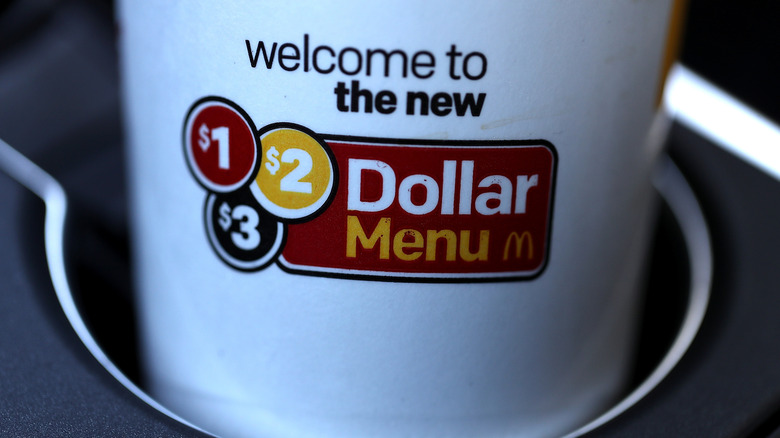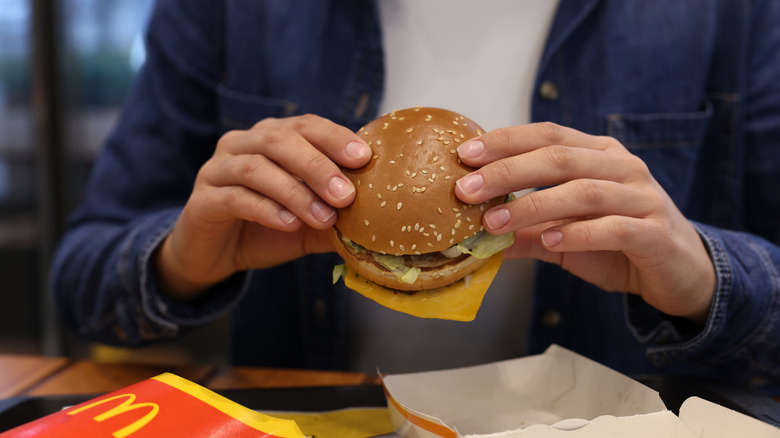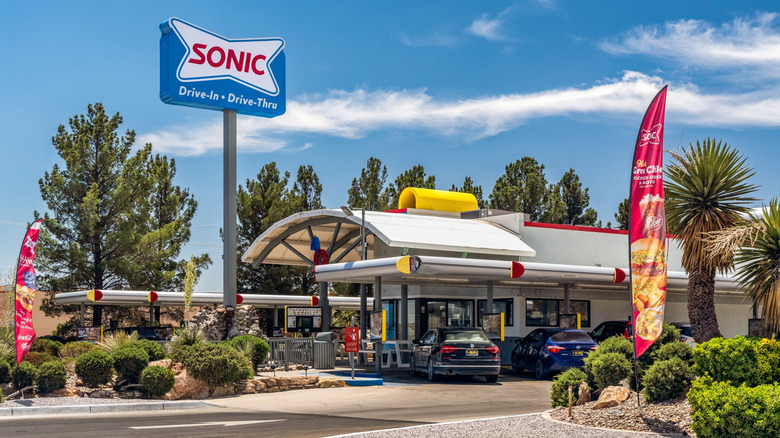Are Fast Food Dollar Menus A Thing Of The Past?
Sometimes it seems like the fastest thing about fast food is how swiftly it changes. Limited-time promotions still come and go, of course — inking a Happy Meal toy deal is still big news for a summer blockbuster. But nowadays, fast food corporations aren't too shy about chasing wider cultural trends. The calorie-counting craze set off by "Super Size Me" pushed many chains to introduce healthier menu options like salads and post their nutritional facts. As customers turned to meat alternatives, big burger joints rushed in to push plant-based patties, with the latest vegetarian option popping up at Carl's Jr. Some restaurants are even outfitted with self-service kiosks and AI-powered drive-thru lanes. But for decades, fast food fans were certain that the dollar menu was something that would never change. The 99-cent Whopper Jr. was once a way of life — today, the same burger is more than four times the price. What happened? And could the dollar menu ever make a comeback?
Many different factors contributed to the death of the dollar menu. Costs have risen, but tastes have changed, too. Customers have become more concerned with how these restaurants source ingredients, and many want healthier, higher-quality fast food options. Eventually, corporations like McDonald's decided it wasn't worth selling cheap food at a loss anymore. Many chains faced backlash from the end of the dollar menu, and it actually had a negative effect on businesses. But now that affordable options are trickling back onto menus, restaurants are hoping customers will return, too.
Why the dollar menu faded away
Ninety-cent burgers always looked like a great deal on the surface, but behind the scenes, it was never sustainable. The McDonald's Dollar Menu launched in 2002, when the corporation was busy introducing all sorts of things — like a catchy new jingle — to jumpstart slumping profits. Unlike many other specials, deals, and promos, the Dollar Menu was marketed as a permanent fixture. In some ways, the strategy worked. Customers flocked to McDonald's, where they could now buy a burger and fries for considerably less than a standard combo meal. But they were also spending less overall, which cut into profit margins.
McDonald's wasn't the first to try this. Wendy's introduced its 99-cent Super Value Meal menu in 1989, and Burger King's similarly priced Great Tastes menu debuted in 1998. But McDonald's was arguably the company most responsible for killing it. In 2013, the Dollar Menu became the Dollar Menu & More, shattering the 99-cent price ceiling for good. Customers weren't happy, and though McDonald's tried new deals to bring them back, foot traffic fell regardless. Over time, competitors' dollar menus faded away, too.
However, the demise of the dollar menu was inevitable. News exposés revealed the brutal treatment of livestock at factory farms and nutritionists warned against the high fat, salt, and sugar contents in fast food. In response, customers turned to fast casual chains like Panera and Chipotle, which offered fresher made-to-order food at a premium price. And as costs rose, fast food corporations reasoned that investing in the quality of their own flagship meals was more worthwhile than racing to the bottom.
New value menus bring new strategies
Leading fast food chains spent the 2010s trying to reignite customer passion for the dollar menu, but it began to make less and less business sense. After a pandemic and another global recession, the cost of operating a fast food franchise is undeniably higher than ever before, and that's been reflected in menu prices. Customers today also expect better ingredients and more sustainable food production, which makes the end product more expensive, too. Prices have gotten so high now that many see fast food as an expensive luxury.
The hunger for some kind of cheaper value menu is still there, and corporations are trying to tap into that desire. While it's no longer economically feasible to sell food for a dollar on a massive scale, chains have been playing with discounted combo meals and limited time deals to hopefully drive the same sales and foot traffic that the dollar menu once brought. McDonald's McValue menu launched with considerable fanfare in 2024, with a "buy one, add one" deal that includes a $1 item with the purchase of a full-priced one. That same year, Sonic Drive-In introduced a permanent "FUN.99" $1.99 value menu, and in early 2025, Burger King ran a weeklong $1 cheeseburger promotion. Many of these deals are tied to each chain's official mobile app, which in some cases offer several daily promotions when customers join a rewards program.


